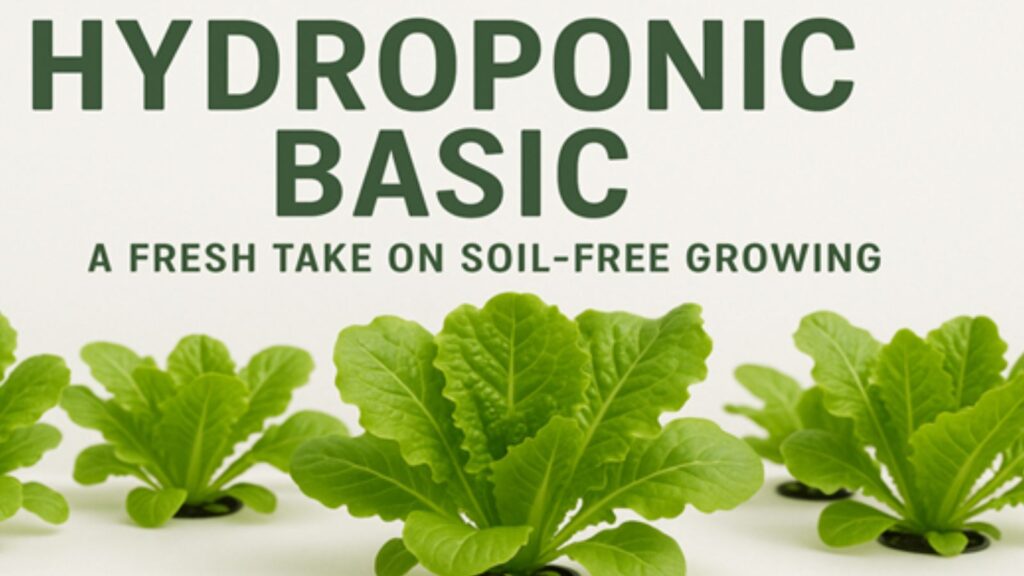
Welcome to the world of hydroponic basics, wonderfully weird and wildly efficient! If you’ve ever wondered whether you can grow leafy greens in your studio apartment or tomatoes in your garage—without soil, dirt, or traditional farming woes—then you’re in for a treat. This guide will walk you through the hydroponic basic principles, breaking it all down into bite-sized, beginner-friendly goodness. And yes, we’ll keep it professional, fun, and maybe just a little bit cheeky. Because why not?
What is Hydroponics, Really?
At its core, hydroponics is a method of growing plants using nutrient-rich water instead of soil. That’s right—no dirt under your fingernails, no battling rogue earthworms. Just clean water, smart science, and a system that lets plants thrive in a controlled environment. When we talk about “hydroponic basics,” we mean understanding this beautiful swap of earth for H₂O.
So how do plants survive without soil? The answer lies in nutrients. Hydroponic systems deliver precisely what plants need directly to their roots. That means faster growth, fewer pests, and often bigger yields. If you want to learn more about hydro systems, Hydroponics360 grower’s knowledge base can be a golden source for you and for all the friends of mother nature.
Why Go Soilless?
We hear you. Dirt’s been around for a while. But here’s why ditching it might be your best decision yet:
- Speedy Growth: Hydroponic plants grow up to 50% faster than their soil-grown cousins. They’re like the overachievers of the botanical world.
- Space-Smart: No garden? No problem. These systems can stack vertically or fit under LED lights in tight indoor spaces.
- Water-Efficient: Ironically, hydroponics uses up to 90% less water than traditional farming. Talk about sustainable smarts.
- No Weeding Necessary: Need we say more?
The Six Hydroponic Basics You Need to Know
Let’s break down the essentials of starting your own hydroponic system.
1. Water (Obviously)
Water is your soil’s replacement, and it needs to be just right—think pH-balanced, filtered, and packed with nutrients. It’s like a smoothie for your spinach. Tap water can work, but reverse osmosis or distilled water is ideal for optimal nutrient absorption.
2. Nutrient Solution
Plants don’t just drink water—they feast on nutrients. The hydroponic basic nutrient mix typically includes nitrogen, potassium, calcium, magnesium, phosphorus, and trace minerals like iron and zinc. These mixes are available in both dry and liquid forms, and thankfully, you don’t need a chemistry degree to use them.
3. Light—Lots of It
Whether you’re using sunlight or artificial LEDs, your plants need proper lighting to photosynthesize and grow. Different plants require different light intensities and schedules, so a bit of research here goes a long way. Pro tip: leafy greens love blue light, while flowering plants respond better to red.
4. Growing Medium
Just because there’s no soil doesn’t mean the roots are left flailing in open water. Hydroponic systems use inert mediums like coconut coir, rockwool, clay pebbles, or perlite to support the plant’s base. Think of it like giving your plant a beanbag chair—comfort with structure.
5. Air & Oxygen
Roots need oxygen too! That’s why most systems include an air pump or air stone to oxygenate the water. Without enough oxygen, roots can rot, and plants can suffocate—kind of a buzzkill for your basil.
6. A Structure or System
There are several hydroponic setups, and choosing the right one depends on your space, budget, and ambition level. Here are the top contenders:
- Deep Water Culture (DWC): Roots hang in nutrient water 24/7. Simple and beginner-friendly.
- Nutrient Film Technique (NFT): Water flows over the roots continuously in a shallow stream.
- Ebb and Flow: Flood and drain method. Great for intermediate growers.
- Wick System: No pumps, just capillary action pulling nutrients to roots. Ideal for low-maintenance setups.
- Aeroponics: Mists roots with nutrients in air. High-tech and high yield.
- Drip Systems: Precise water drips deliver nutrients directly to roots. A favorite for larger operations.
Setting Up Your First Hydroponic System
So now that you’re well-versed in basic hydroponic knowledge, let’s talk action. Starting your first system can be as easy—or as complex—as you want it to be.
Start Small and Scale Up
Begin with herbs or leafy greens like lettuce, kale, or basil. They’re forgiving, fast-growing, and perfect for learning. You can find starter kits online that walk you through the process with minimal setup.
Monitor and Tweak
Keep an eye on pH (ideal range is 5.5 to 6.5), water temperature (65-75°F), and nutrient concentration (measured with an EC or TDS meter). Think of it like babysitting a very quiet, chlorophyll-filled toddler.
Learn Through Doing
You don’t need to memorize botany textbooks. Just stay curious and adaptable. Each plant might react a little differently, but that’s part of the charm—and the challenge.
Hydroponic Challenges (And How to Outsmart Them)
Like anything worthwhile, hydroponics has its quirks. But don’t worry—we’ve got solutions sharper than a cactus in July.
Algae Growth
Sunlight plus water equals algae. This green invader can clog up your system and compete with plants for nutrients. Use opaque containers, keep light away from the water, and scrub regularly to keep algae at bay.
Nutrient Imbalances
Too much of a good thing is still too much. Over-fertilizing can burn your plants. Under-fertilizing leaves them hungry and sad. Stick to manufacturer guidelines and track your solution’s electrical conductivity to stay balanced.
Root Rot
Stagnant water and low oxygen levels can lead to root rot—a silent killer. Use air stones or pumps, and never let roots sit in still, warm water for too long.
Equipment Failures
Pumps stop. Lights flicker. Stuff happens. Setting up alerts and regular check-ins will save you from surprise disasters. And always have a backup plan—plants aren’t great at forgiving negligence.
FAQs
Is hydroponics expensive to start?
Not necessarily. Starter kits can be very affordable. You can DIY many systems with simple supplies. As your setup grows, costs will scale with your ambitions.
Do hydroponic plants taste different?
Not really—unless you count “fresher and cleaner.” Some say hydroponic veggies even taste better due to controlled growing conditions.
Can I grow fruit with hydroponics?
Absolutely! Strawberries, tomatoes, and even melons can be grown hydroponically. Just be aware that fruiting plants need more light and space.
What’s the easiest plant to start with?
Lettuce. Hands down. It grows fast, doesn’t need fancy lighting, and tolerates newbie mistakes.
How long does it take to see results?
Fast growers like greens show results in just a few weeks. You’ll be harvesting your first salad before most houseplants even sprout.














